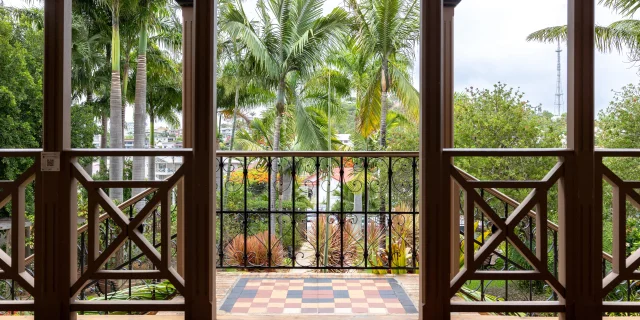This 19th-century colonial building, which was the first bank in New Caledonia (Marchand bank established in 1874), was bought by the town in 1880, and served as the town hall until 1975. Since 1996, it has housed the Nouméa City Museum. Spread over three levels, you can step back in time to the Nouméa of the 1900s and then of the First World War. Alongside significant historical events, you’ll discover the daily lives of New Caledonians in Nouméa and the bush. Focusing on New Caledonian history from 1853 to 1953, the museum retraces the establishment of the capital, the installation of the penal colony, and other significant periods that have shaped the territory.
Don’t forget to visit the museum shop, which stocks books on the period from 1853 to the present day.
Inside the American semi-circular building from the Pacific War era, you’ll find exhibitions depicting life in New Caledonia during the Second World War: rallying to Free France, the departure of volunteers from New Caledonia and the Kanak people to the front, the expulsion of Japanese residents from the colony following the attack on Pearl Harbor, the establishment of rear bases for Australian, American, and New Zealand forces in the New Caledonian archipelago, and the transformation of society.
Free access to tablets for two digital tours:
– “Musée 3D, faces cachées des objets”, (3D Museum: the hidden sides of objects), a 3D object discovery tour in French, English, Japanese, and French sign language, and
– “Mésaventures de guerre” (War Misadventures), a stage-based game for young audiences in French.
Located in the former civil prison since 1996, the Centre d’Art is a municipal facility hosting live (theatre, music, dance) and visual (audiovisual and visual arts) performances, film screenings, and other events. The eclectic programming in the Théâtre de Poche’s intimate space makes it a meeting place and a showcase for New Caledonia’s cultural scene. In fact, although some shows come from mainland France or other countries, most events are created in the territory by local New Caledonian artists.
Maison Célières is an emblematic cultural heritage site in Nouméa. Built in the 19th century, it bears witness to the history of New Caledonia. With its architecture typical of the period, Maison Célières offers a fascinating glimpse of life in the past through its carefully restored rooms. Visitors can discover period furniture, historical objects, and exhibits telling the story of New Caledonia. It’s a must-see for history and heritage lovers, offering a unique immersion into the region’s past.
Guided tour of Maison Célières: every first Saturday of the month and every third Wednesday of the month.
Maison Higginson is believed to have been built by Gabriel Laroque on land purchased from John Higginson, founder of the Le Nickel company. It was acquired by the City of Nouméa and is intended to host historical and heritage exhibitions, as well as exhibitions of contemporary art and creations.
Completely redesigned, the Maritime Museum explores the maritime history of New Caledonia, and features the extraordinary La Pérouse expedition collection.
The permanent exhibition is divided into four spaces that will enthral young and old alike.
• The sails of trade: the history of ore carriers and tall ships.
• The La Pérouse expedition: preparations for the expedition and the research conducted to locate the shipwreck site.
• New Caledonian links: New Caledonian coastal maritime links.
• Maritime migrations: the history of migration waves in New Caledonia.
There are also play areas for children and adults to discover the story.
A dynamic space to better understand the history of the Caledonian archipelago, shaped by the sea, and to discover the extraordinary testimonies of the La Pérouse expedition.
Winner of the 2020 Travellers’ Choice Best of the Best award presented by TripAdvisor.










